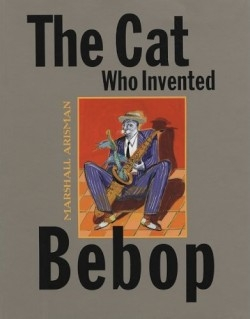The Cat Who Invented Bebop
This whimsical story imagines the invention of bebop music as the production of jazz-playing cats who “were so cool they had their own language.” It chronicles the adventures of one Stringbean McCoy, a “cool kitten” born to a family “as square as boxes” who “loved him but not his music.” Readers will laugh at Stringbean’s inexplicably imaginative invention of bebop music by playing his saxophone using his forelegs to play one tune and his hind legs for another.
As a “cool kitten,” Stringbean studies music with Pops, a “cool cat” mentor whose gentle encouragement helps him learn to play only the right notes even when his saxophone squeaks loudly and often. By the time Stringbean graduates from “Catsville High,” he is a good musician, even though he still plays “too many notes at a time.” He saves his money until he has enough for a train ticket from his home in the Mississippi Delta to New York City. Caught in his first snowstorm, he meets Cat-Dance Johnson, who points him to a jazz club called the Blue Devil Lounge. Summoning all his courage, Stringbean climbs onstage and begins playing with the band. His debut goes well, until he begins a solo and notices that it is neither cool nor fast enough. His moment has arrived: “Still playing the melody of ‘Don’t Start Me Talkin’” with his front paws, Stringbean strips off his shoes and, with his hind paws, plays the notes to a completely different song, “Mississippi Blues.” Electrified by the new sounds, the other band members are quick to follow suit, thereby inventing bebop and changing jazz music for all time.
Author and illustrator Marshall Arisman is an internationally known artist who chairs the M.F.A. program at the School of Visual Arts in New York City. One of the foremost illustration teachers in the United States, he paints, sculpts, and writes, and his documentary, Marshall Arisman: Facing the Audience, is due out soon. A saxophone player just like Stringbean McCoy, he clearly understands how art and music can connect, especially for young children for whom one medium can generate interest in another. His other children’s book is The Wolf Who Loved Music.
Reviewed by
Elizabeth Breau
Disclosure: This article is not an endorsement, but a review. The publisher of this book provided free copies of the book to have their book reviewed by a professional reviewer. No fee was paid by the publisher for this review. Foreword Reviews only recommends books that we love. Foreword Magazine, Inc. is disclosing this in accordance with the Federal Trade Commission’s 16 CFR, Part 255.

